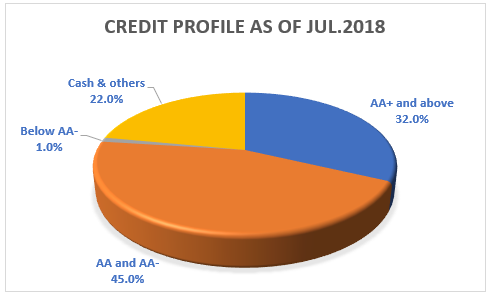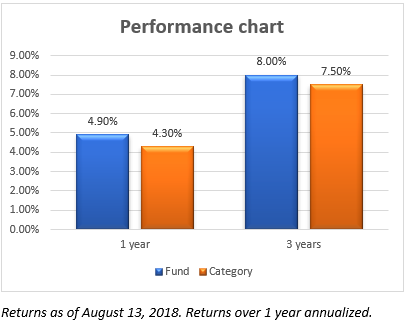- What: A medium duration debt fund
- Why: Generates superior returns while balancing risks
- Whom: Investors with a risk appetite and looking for NCD-like returns with better tax efficiency
UTI Medium Term is a superior alternative to owning the recent spate of NCDs or corporate FDs on offer. The fund has a portfolio of high and medium quality papers and can balance risk and return to deliver returns better than the above traditional options. While it’s current 1-year return is not much to speak of, on a rolling 1-year basis over the past 3 years, the fund delivered 8.7%. This return comes from risks lower than traditional credit risk funds.
In the current climbing interest rate scenario, funds such as UTI Medium Term can generate high accrual (interest income from underlying instruments) with superior tax efficiency.
The fund and suitability
UTI Medium Term is a ‘medium duration’ fund under SEBI’s category. Funds in this category can have a Macaulay Duration of 3-4 years as per regulation. However, the regulation does not state anything about the credit profile of funds in this category. As a result, there are funds, that take slightly higher risk in the medium duration space and UTI Medium Term is one of them. The fund held about 46% in instruments with credit rating below AA+ as of July 2018. This is far higher than the category average of about 35%. UTI Medium Term held anywhere between 43-56% in instruments below AA+ in the last 1 year. Hence, its risk profile is between that of a medium duration fund and a credit risk fund.
UTI Medium Term is suitable for investors with some risk appetite and willing to hold for not less than 3 years. The fund delivers returns that are comparable with credit risk funds but comes with a much lower risk profile than the latter. It is not for low-risk investors or for those with a short time frame. The fund is not meant for immediate income generation and must be held for 2-3 years before considering any systematic withdrawal option.
Performance and portfolio
UTI Medium Term was launched in March 2015 and therefore does not have a very long track record. However, it has now seen a low rate scenario and is currently experiencing a climbing rate scenario. At its best in late 2016, its 1-year returns were close to 11%. At its worst now, the 1-year returns are little under 5%. However, the low return is on account of volatility in the AAA and AA traded instruments and not due to poor performance. It’s 1-year returns is still 50 basis points higher than its category.
We are unable to roll its 3-year returns sufficiently given the limited track record. However, the limited data suggests that the fund’s worst 3-year return is still 8% annualized. In a climbing rate scenario, this can be expected to be higher.
The fund offers a superior quality portfolio to credit risk funds (which are meant to deliver higher returns with higher risk). In fact, the average rolling 1-year return of the fund, at 8.7% is marginally higher than the credit risk category average of 8.4%. This simply means that the fund can deliver superior returns for lower risk. This is one reason why we replaced its sister fund UTI Credit Risk, in our researched list, with UTI Medium Term. The former fund had an average 65% credit holding in the past 12 months but was not significantly better than UTI Medium Term, which held an average 50% in such instruments.

The fund appears conscious of maintaining liquidity. Less than 10% of its papers are unlisted. Besides, it tactically ups cash & equivalents. The later is presently 20% of its portfolio, although this dynamically varies between 5%-20%
UTI Medium Term has a yield to maturity of 9.64% as opposed to UTI Credit Risk’s YTM of 9.55%. When we say credit risk, it is important to know where the credit risk comes from. For UTI Medium Term it is not from low rated A papers. Much of the credit risk is in AA, which is not high risk. With pure credit risk funds, the credit holding is in lower-rated instruments. Just to put this in perspective, the average holding of a credit risk fund is instruments below AA- is 23%. This is 2% for UTI Medium Term. Active picking of papers and making use of price anomalies in the market appears to be the key behind the fund having a high coupon as opposed to taking risks to build a high interest portfolio.
UTI Medium Term has an AUM of Rs 227 crore and is managed by Amandeep Singh Chopra and Ritesh Nambiar.
FundsIndia’s Research team has, to the best of its ability, taken into account various factors – both quantitative measures and qualitative assessments, in an unbiased manner, while choosing the fund(s) mentioned above. However, they carry unknown risks and uncertainties linked to broad markets, as well as analysts’ expectations about future events. They should not, therefore, be the sole basis for investment decisions. To know how to read our weekly fund reviews, please click here.









The second para of this article mentioned about tax efficiency, however nothing much was elaborated later. “In the current climbing interest rate scenario, funds such as UTI Medium Term can generate high accrual (interest income from underlying instruments) with superior tax efficiency.”
Would be nice if someone can though more light on tax implications after entering this fund.
Hello Sir, compared with FDs, debt funds enjoy indexation benefits. Please read about it here: https://www.fundsindia.com/blog/general/fundsindia-explains-capital-gains-and-indexation/9178 Thanks, Vidya
The second para of this article mentioned about tax efficiency, however nothing much was elaborated later. “In the current climbing interest rate scenario, funds such as UTI Medium Term can generate high accrual (interest income from underlying instruments) with superior tax efficiency.”
Would be nice if someone can though more light on tax implications after entering this fund.
Hello Sir, compared with FDs, debt funds enjoy indexation benefits. Please read about it here: https://www.fundsindia.com/blog/general/fundsindia-explains-capital-gains-and-indexation/9178 Thanks, Vidya